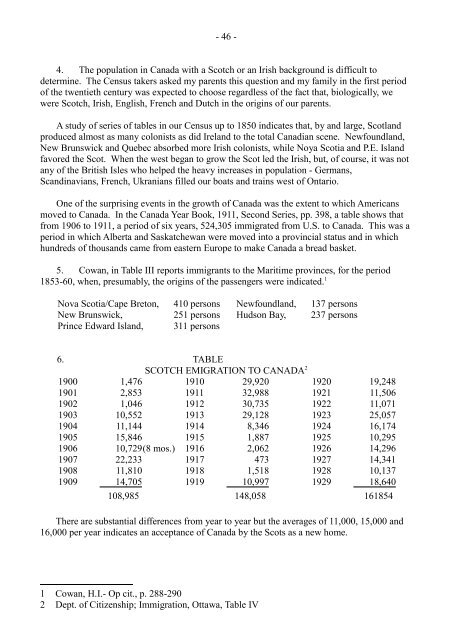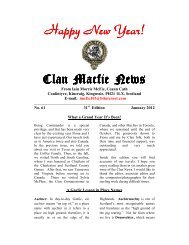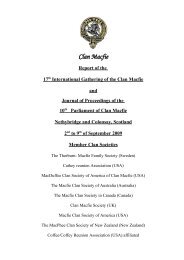Mythology, traditions and history - The Clan Macfie Society
Mythology, traditions and history - The Clan Macfie Society
Mythology, traditions and history - The Clan Macfie Society
You also want an ePaper? Increase the reach of your titles
YUMPU automatically turns print PDFs into web optimized ePapers that Google loves.
- 46 -<br />
4. <strong>The</strong> population in Canada with a Scotch or an Irish background is difficult to<br />
determine. <strong>The</strong> Census takers asked my parents this question <strong>and</strong> my family in the first period<br />
of the twentieth century was expected to choose regardless of the fact that, biologically, we<br />
were Scotch, Irish, English, French <strong>and</strong> Dutch in the origins of our parents.<br />
A study of series of tables in our Census up to 1850 indicates that, by <strong>and</strong> large, Scotl<strong>and</strong><br />
produced almost as many colonists as did Irel<strong>and</strong> to the total Canadian scene. Newfoundl<strong>and</strong>,<br />
New Brunswick <strong>and</strong> Quebec absorbed more Irish colonists, while Noya Scotia <strong>and</strong> P.E. Isl<strong>and</strong><br />
favored the Scot. When the west began to grow the Scot led the Irish, but, of course, it was not<br />
any of the British Isles who helped the heavy increases in population - Germans,<br />
Sc<strong>and</strong>inavians, French, Ukranians filled our boats <strong>and</strong> trains west of Ontario.<br />
One of the surprising events in the growth of Canada was the extent to which Americans<br />
moved to Canada. In the Canada Year Book, 1911, Second Series, pp. 398, a table shows that<br />
from 1906 to 1911, a period of six years, 524,305 immigrated from U.S. to Canada. This was a<br />
period in which Alberta <strong>and</strong> Saskatchewan were moved into a provincial status <strong>and</strong> in which<br />
hundreds of thous<strong>and</strong>s came from eastern Europe to make Canada a bread basket.<br />
5. Cowan, in Table III reports immigrants to the Maritime provinces, for the period<br />
1853-60, when, presumably, the origins of the passengers were indicated. 1<br />
Nova Scotia/Cape Breton, 410 persons Newfoundl<strong>and</strong>, 137 persons<br />
New Brunswick, 251 persons Hudson Bay, 237 persons<br />
Prince Edward Isl<strong>and</strong>, 311 persons<br />
6. TABLE<br />
SCOTCH EMIGRATION TO CANADA 2<br />
1900 1,476 1910 29,920 1920 19,248<br />
1901 2,853 1911 32,988 1921 11,506<br />
1902 1,046 1912 30,735 1922 11,071<br />
1903 10,552 1913 29,128 1923 25,057<br />
1904 11,144 1914 8,346 1924 16,174<br />
1905 15,846 1915 1,887 1925 10,295<br />
1906 10,729(8 mos.) 1916 2,062 1926 14,296<br />
1907 22,233 1917 473 1927 14,341<br />
1908 11,810 1918 1,518 1928 10,137<br />
1909 14,705 1919 10,997 1929 18,640<br />
108,985 148,058 161854<br />
<strong>The</strong>re are substantial differences from year to year but the averages of 11,000, 15,000 <strong>and</strong><br />
16,000 per year indicates an acceptance of Canada by the Scots as a new home.<br />
1 Cowan, H.I.- Op cit., p. 288-290<br />
2 Dept. of Citizenship; Immigration, Ottawa, Table IV






